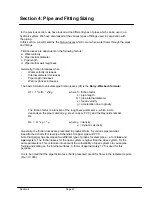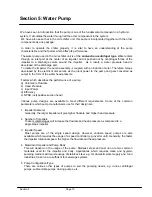
Water Flow Limitations
The factors which determine the water velocity limits are noise, erosion and installation cost. If the
piping is too small, noise and erosion levels will become unfavourable even though the cost is
more economical. Conversely, choosing a larger pipe will incur higher costs.
It is recommended that the following guidelines to be used for the mini chiller units:
1. The pipe friction loss used for the design of the system should be between
1 to 4
ft per 100
ft
of equivalent pipe length.
2. The velocity in the pipe should be less than 4 fps in view of the allowable noise level
generated for residential and commercial buildings.
However, the noise is not caused by the water itself, but rather by free air, sharp pressure
drops, turbulence, cavitation and flashing. If precautions are taken to eliminate air and
turbulences, higher velocities up to 8 fps are acceptable.
3. The minimum velocity in the pipe should be
1.5 - 2 fps to allow air entrained in the water to be
carried to separation units (e.g. expansion tanks, locations of lowest pressure) for venting.
Taking into consideration (2) and (3) above, it is recommended that the water velocity in the
pipe to be
2 - 8 fps.
With this, the expected service life of the pipes is more than 8000
hours/year.
Conversion factors:
1 fps = 0.305 m/s
1 ft water = 248.84 Pa
1 ft = 0.305 m
Example:
All the mini chiller units are with 1-1/4" pipe connections. Installation with 1-1/4" and 1" piping is
possible, as shown in the following calculation for steel Sch 40:
Pipe size 1-1/4"
Pipe size 1"
Internal diameter = 1.3799" Internal diameter = 1.0488"
Cross sectional area = 0.0104 ft
2
Cross sectional area = 0.006 ft
2
Section 4
Page 68
Summary of Contents for AC 40A
Page 1: ...AM MAC ...
Page 153: ...Appendix 1 ...
Page 154: ...Appendix 2 Appendix 2 ...
Page 157: ...GRAPH OF PRESSURE DROP VS FLOW FOR VARIOUS C V RATINGS Appendix 5 1 ...
Page 158: ......
Page 159: ...Water Capacity Graph Appendix 5 2 ...
Page 160: ...CHART 3 FRICTION LOSS FOR CLOSED PIPING SYSTEMS Appendix 6 1 ...
Page 161: ...CHART 4 FRICTION LOSS FOR OPEN PIPING SYSTEMS Appendix 6 2 ...
Page 162: ...CHART 5 FRICTION LOSS FOR CLOSED AND OPEN PIPING SYSTEMS Appendix 6 3 ...
Page 168: ...Appendix 8 Appendix 8 ...
Page 169: ...Appendix 8 1 ...
Page 170: ...Appendix 8 2 ...
Page 171: ...Appendix 8 3 ...
Page 172: ...Appendix 8 4 ...
Page 173: ...Appendix 8 5 Appendix 8 5 ...
Page 174: ...Appendix 8 6 Appendix 8 6 ...
Page 175: ...Appendix 8 7 Appendix 8 7 ...
Page 176: ...Appendix 9 ...
Page 178: ...Appendix 11 1 Appendix 11 1 ...
Page 179: ...Appendix 11 2 Appendix 11 2 ...
Page 180: ...Appendix 13 ...
Page 181: ...Appendix 13 1 ...
Page 182: ...Appendix 14 Appendix 14 ...
Page 183: ...Appendix 15 1 Appendix 15 1 ...
Page 186: ...Appendix 17 Appendix 17 ...
Page 187: ...Appendix 18 ...
Page 188: ...CE20DW CE25DW Note PRESSURE DROP CORRECTION FACTOR 1 2947 0 0021 EWTºF Appendix 19 ...
Page 189: ... 2003 McQuay International 603 55194922 www mcquayup com ISO 9002 REGISTERED ...
















































